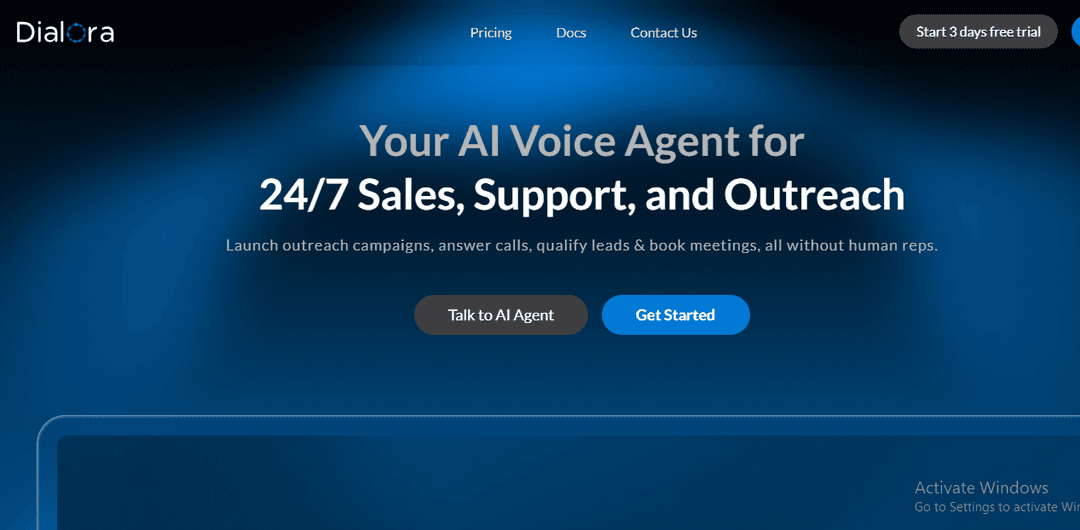
17 Nov 2025
The future of voice AI is here, and it is changing the process of communication between people and companies. Voice technology is now taking over tasks that used to require whole human teams. The best part? These systems now sound so natural that you are not sure whether you are communicating with a person or a machine.
The AI chat devices are capable of talking, understanding and acting in real time, which is driving this growth. In the Future of Voice AI, five names are leading this revolution- Edysor AI, Dialora AI, Bland AI, Voiceflow AI, and Vapi AI. These platforms are automated differently in the communication process hence making them some of the best AI voice tools in the modern world.
These systems are making life easy. Whether it is a counselor talking to a student or a business handling thousands of calls per day. The future of voice AI is all about speed, accuracy and natural communication - the intelligent automation, and human compassion.
To understand the future of voice AI, we first need to know what makes a great voice agent. The best AI conversational platforms have multiple similarities, they understand context, sound human, and learn fast.
A strong voice AI system cannot only talk, but also listens, remembers and converses intelligently. It must be capable of handling complex conversation, integration with CRMs, security and compliance. The best AI voice tools can also be applied to other languages, accents, and platforms, ensuring everyone feels heard.
Scalability is the other factor that has a significant impact on the future of voice AI. It will never go unnoticed when a platform can serve 10 or 10000 calls and can do its job in the same quality. Best of all, the ideal system is a system that is less technical and more human-warming, providing a balance between automation and empathy.
In the comparison of such solutions as Edysor AI and Dialora AI comparison, we may see how both of them follow these principles differently. Edysor is personalized and education-oriented, but Dialora is business automation and the fact that it can be established very fast. Together, they prove the level of diversity and excitement that AI voice applications will have in the future.
Edysor AI shows what the future of voice AI looks like in the education sector. It behaves less like software and more like an actual counselor talking to a person digitally.
Edysor remembers all the replies, keeps an exchange of discussions and connects the student with a real counselor in case of human assistance. It will process thousands of calls at the same time, and each interaction still feels individual.
This is a system that integrates deep learning and real-time integration, Salesforce, HubSpot, WhatsApp, and academic CRM to keep all of the inquiries in order. It is 24/7 and filters out weak leads and allows the counselors to work in areas that are in most demands.
Its architecture is determined by data security. The platform is also among the safest AI-based conversational, as it is GDPR and FERPA compliant, encrypted, and permission-based recording.
Edysor AI is not an automated speech but it recreated empathy as an automated process. That is what makes it the so-called human voice of the future of voice AI.
In any Edysor AI and Dialora AI comparison, Dialora shines for speed and simplicity. It is a no-code system and can be deployed by teams of small size and can be installed during the morning, before lunch and then the teams may initiate calls in the evening.
Dialora consists of inbound, outbound communication system, automatic response of questions, booking of appointments, and qualification lead system. It is integrated with usual business solutions Salesforce, HubSpot, Pipedrive, Google Calendar, and Twilio which simplify the working process.
Dialora applies the OpenAI and 11Labs models to deliver the answer within less than 400 milliseconds and in a manner that is natural. This is what makes the conversations human and professional.
Dialora creates small businesses and makes them efficient businesses that can be accessed at any time. This is the best AI voice application to have the look of a large credible and attentive proprietor to individuals who cannot afford a call center that is operational full-time. It shows that voice AI will not be the prerogative of the giant companies to possess the future of voice AI, but that voice AI is democratized and available to everyone.
If Edysor and Dialora make the life of users easier, Bland AI gives total creative freedom to developers. It provides the engineer with the canvas controlling the future of voice AI, which allows them to be in total control of the API of the behaviour of each and every call.
Webhooks enable the developers to program logic, decide when a call should be escalated, choose the models, and introduce custom workflows. It is precision without compromise.
Bland promotes speech generation under the sub-second and does not have any LLM- OpenAI or even an in-house model. It has pre-built retry logic, voice mail processing and event processing.
Bland is not a product, but a toolkit in the case of groups that build unique experiences for customers or research projects. It renders the AI conversational platforms movement visible, technical and infinitely customizable--and this is how innovation should be lived through.
Designers see the future of voice AI differently: as storytelling. Voiceflow visualizes such a creative process. The dialogue blocks in the form of story scenes are dragged and dropped until the dialogue processes naturally.
Entire voice or chat assistants can be prototyped and tone and timing can be tested and instant previews can be shared too. No one is a writer of the code and everyone can imagine how a genuine conversation can occur.
Voiceflow operates either on channels e.g. Alexa-style voice applications, web chat, or in-app assistants that integrate live data through third-party APIs. It is a prototype of the best AI voice tools, which help brands to consider the voices before dedicating themselves to their full development.
The result is a faster pace of experimentation and the elimination of blind spots- a crucial benefit as firms transition to the interactive and customized future of voice AI.
Vapi AI has the spirit of freedom, which is an open-source system and it believes that voice AIs are meant to be shared, not siloed in the future. It enables programmers to host, edit and scale the code themselves and makes any user a co-creator.
Vapi supports the conversations in their unmodified form without any form of latency (less than 500 milliseconds). It also provides real time WebSocket and webhook API when it comes to the flow of data between systems.
It is open-source and is linked to OpenAI, Claude, and other notable models and possesses a more transparent architecture to make it add value by the developer community.
In a market dominated by closed platforms, Vapi is a breath of fresh air. Innovation becomes faster when it’s open. Regular project updates to the community make the project one of the most inspiring projects on how the future of voice AI can be made accessible to everyone.
In order to bring into full realization how such platforms will be utilized in the future of voice AI, it is interesting to draw the curtain back. Every exchange with an AI voice agent is anchored on a set of smart processes that last in the milliseconds.
Among these processes, the system can be merged with CRMs, APIs and databases - retrieve records, make a call or review information in real time. This pipeline, when combined, allows AI conversational platforms to serve thousands of special interactions in real-time and is the future of voice AI.
The most adopted top areas include education, healthcare, e-commerce, and customer service since they need a high number of calls and personalization.
The optimal solutions include Edysor and Dialora, which are both GDPR and FERPA-compliant and are guaranteed to provide encrypted communication and user consent.
It is also the most human-like education assistant since it has a student-based tone, memory-based interactions, and built-in CRM integration.
Yes. Vapi AI is flexible and transparent, which demonstrates that open platforms can be as good (and even better) than closed systems.
No. They complement a team by automatically calling repetitive calls and leaving human agents to cases with emotion or more complex cases.
Realism, empathy, security, and adaptability - in order to make the communication between human and machines appear to be more natural.
The future of Voice AI is not about automation, but building smart systems which are able to understand people correctly. Edysor, Dialora, Bland, Voiceflow, and Vapi are considered to be the various forces, but all of them are directed at creating a more human-like, faster, and smooth conversation.
As the amount of technology grows, these AI conversational platforms will alter the character of how organizations communicate with their audiences. The future of the voice AI, be it in education, business or customer care, is here, and it is already now and the voice is more human than ever.
Resources
Others
All rights reserved. Powered by Edysor
